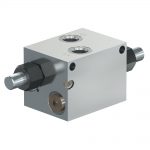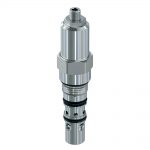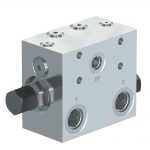HYDRAULIC LOAD AND MOTOR CONTROL VALVES
HYDRAULIC LOAD AND MOTOR CONTROL VALVES
Hydraulic Load and Motor Control Valves
Parker’s piloted load control valves are designed to operate independent of downstream pressure to prevent runaway loads under dynamic conditions using a pilot signal, handling pressures up to 420 bar (6000 psi) and flows up to 350 lpm (90 gpm).
Parker’s piloted load holding/counterbalance valves are a combination of a relief, sequence, and flow control valve that can handle pressures up to 420 bar (6000 psi) and flows up to 350 lpm (90 gpm). These robust valves allow the operator to maintain control of the load by preventing it from overrunning the pump while also protecting against thermal expansion. The wide selection of pilot ratios enables the valve to open based off a given backpressure specific to the application, which could be much lower than the spring pressure setting. This feature allows predictable and consistent control of a load throughout its lowering cycle.
Markets:
• Aerial
• Construction Equipment
• Material Handling Equipment
• Miscellaneous Industrial
• Miscellaneous Mobile
Features/Benefits:
• Hardened, precision ground parts for durability
• Poppet style construction with minimal leakage
• Tamperproof versions available
• Single cartridge valve with integral reverse flow check valve
• Available pilot ratios 8:1 to 1.5:1
• All external parts zinc plated
Applications:
• Load holding
• Position holding
Additional Technical Insight:
The load control valves are load assisted i.e the pilot pressure acts on the difference between the setting and the load at the pilot ratio.
It should always be set at a minimum of 30% higher than the maximum load induced pressure to ensure the valve closes correctly.
Sizing a counterbalance valve needs care in that the flow required is usually higher than system pump flow, as in the case with a cylinder application (retract flow could be twice the system flow) though oversizing the valve could cause instability.
Because of dynamic load variations in many applications, it may be necessary to use a lower pilot ratio or fit an orifice in the pilot line in order to gain stability. The valve will be affected by backpressure and care must be taked with proportional and closed center systems.
Parker’s vented load control valves are designed to operate independent of downstream pressure to prevent runaway loads under all dynamic conditions, handling pressures up to 350 bar (5000 psi) and flows up to 113 lpm (30 gpm).
Parker’s vented to atmosphere load holding/counterbalance valves are a combination of a relief, sequence, and flow control valve that can handle pressures up to 350 bar (5000 psi) and flows up to 113 lpm (30 gpm). These robust valves allow the operator to maintain control of the load by preventing it from overrunning the pump while also protecting against thermal expansion. The wide selection of pilot ratios enables the valve to open at pressures much lower than the spring pressure setting, allowing consistent control of the load throughout its lowering cycle. Because these valves spring chamber are vented to atmosphere, the valve will not be affected by changes in return pressure. Parker’s vented load holding valves are ideal in closed center circuits where there is need to control pressure using an auxiliary relief valve.
Markets:
• Aerial
• Construction Equipment
• Material Handling Equipment
• Miscellaneous Industrial
• Miscellaneous Mobile
Features/Benefits:
• Vented to atmosphere, no additional drain line required
• Hardened, precision ground parts for durability
• Poppet style construction with minimal leakage
• Tamperproof versions available
• Single cartridge valve with integral reverse flow check valve
• Available pilot ratios from 8:1 to 3:1
• All external parts zinc plated
Applications:
• Load holding
• Position holding
Additional Technical Insight:
The load control valves are load assisted i.e the pilot pressure acts on the difference between the setting and the load at the pilot ratio.
The valve should always be set at a minimum of 30% higher than the maximum load induced pressure to ensure the valve closes correctly.
Sizing a counterbalance valve needs care in that the flow required is usually higher than system pump flow, as in the case with a cylinder application (retract flow could be twice the system flow) though oversizing the valve could cause instability.
Because of dynamic load variations in many applications, it may be necessary to use a lower pilot ratio or fit an orifice in the pilot line in order to gain stability.
Manifold Mounted Motor Control Valve capable of pressures up to 210 bar (3000 psi) and flows up to 56 lpm (15 gpm). Designed to direct mount on TB, TE, TF, and TG series Parker Low Speed, High Torque motors.
Parker’s Manifold Mounted Motor Control Valve is designed to mount directly to Parker’s TB, TE, TF, and TG series Low Speed, High Torque Motors to provide a reliable and compact solution. The control valves have the option to be configured as single-direction or dual-direction counterbalance valves with an integrated brake release shuttle depending on application needs. These valves are capable of performing up to pressures of 210 bar (3000 psi) and flows up to 56 lpm (15 gpm) in order to meet application requirements on a wide range of machinery within several markets, such as aerial equipment, construction, and material handling.
Markets:
• Aerial
• Construction Equipment
• Mining Equipment
• Material Handling Equipment
• Miscellaneous Industrial
• Miscellaneous Manufacturing
• Miscellaneous Mobile
Features/Benefits:
• Hardened and precision ground parts for long life
• Compact size for reduced space requirements
• Low leakage design
• Fluorocarbon seals standard
Applications:
• Hydraulic Motor control
Additional Technical Insight:
These can be configured with single or dual, vented or non vented load control valves and either with a 10:1 or a 1:1 pilot ratio.



